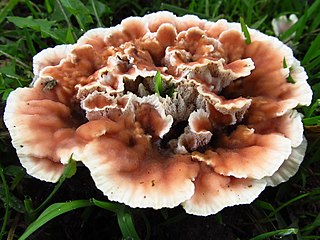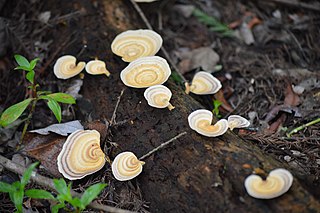
The Hymenochaetales are an order of fungi in the class Agaricomycetes. The order in its current sense is based on molecular research and not on any unifying morphological characteristics. According to one 2008 estimate, the Hymenochaetales contain around 600 species worldwide, mostly corticioid fungi and poroid fungi, but also including several clavarioid fungi and agarics. Species of economic importance include wood decay fungi in the genera Phellinus and Inonotus sensu lato, some of which may cause losses in forestry. Therapeutic properties are claimed for Inonotus obliquus ("chaga") and Phellinus linteus, both of which are now commercially marketed.

The Polyporaceae are a family of poroid fungi belonging to the Basidiomycota. The flesh of their fruit bodies varies from soft to very tough. Most members of this family have their hymenium in vertical pores on the underside of the caps, but some of them have gills or gill-like structures. Many species are brackets, but others have a definite stipe – for example, Polyporus badius.

Pseudochaete is a genus of green algae, in the family Chaetophoraceae. However, this genus is not recognized by all authorities, sometimes being considered part of genus Stigeoclonium.

The Hymenochaetaceae are a family of fungi in the order Hymenochaetales. The family contains several species that are implicated in many diseases of broad-leaved and coniferous trees, causing heart rot, canker and root diseases, and also esca disease of grapevines. According to a standard reference text, the family contains 27 genera and 487 species.

Phylloporia is a genus of polypore fungi in the family Hymenochaetaceae. A 2012 estimate placed 23 species in the genus; this number was increased to 30 by 2015.

Porodaedalea is a genus of fungi in the family Hymenochaetaceae. The genus was circumscribed by American mycologist William Alphonso Murrill in 1905.

Trichaptum is a genus of poroid fungi. The genus was circumscribed by American mycologist William Alphonso Murrill in 1904. Formerly classified in the family Polyporaceae, several molecular studies have shown that the genus belongs to the order Hymenochaetales.

Pycnoporellus is a genus of fungi in the family Fomitopsidaceae. The widespread genus, circumscribed by American mycologist William Alphonso Murrill in 1905, contains two species.

Amauroderma is a genus of polypore fungi in the family Ganodermataceae. The genus, widespread in tropical areas, contains about 70 species. Amauroderma fungi are wood-decay fungi that feed and fruit on decayed branches and trunks.

Abortiporus is a genus of fungi in the family Meruliaceae. The widely distributed genus contains three species. Species in the genus grow on the wood of hardwoods and conifers, either alone or around the stumps and living trees. It causes a white rot in dead wood and a white trunk rot in living wood. The genus was circumscribed in 1904 by William Alphonso Murrill. The generic name is derived from the Latin abortus and the Ancient Greek πόρος (pore).

Aurantiporus is a genus of poroid fungi in the family Meruliaceae. Circumscribed by American mycologist William Alphonso Murrill in 1905, the genus contains five species found mostly in northern temperate regions. Molecular analysis of several Aurantiporus species suggests that the genus is not monophyletic, but some other related polypore species need to be sequenced and studied before appropriate taxonomic changes can be made. In 2018, Viktor Papp and Bálint Dima proposed a new genus Odoria to contain Aurantiporus alborubescens based on multigene phylogenetic analyses. The generic name is derived from the Latin aurantius ("orange") and the Ancient Greek πόρος (pore).

Globifomes is a fungal genus in the family Polyporaceae. It is a monotypic genus, containing the single North American species Globifomes graveolens, commonly known as sweet knot. This fungus is found fruiting singly or in groups on trunks or logs of hardwood trees, primarily oaks. The fruit body consists of a mass of small overlapping hoof-shaped caps arising from a common core. It is initially dull yellow-brown with tan petal-shaped margins, aging to dark brown.

Microporellus is a genus of poroid fungi in the family Polyporaceae.

Nigrofomes is a genus of fungi in the family Polyporaceae. It was circumscribed by mycologist William Alphonso Murrill in 1904 with N. melanoporus as the type and only species. This fungus, first described as Polyporus melanoporus from collections made in Cuba, is common in tropical America. N. nigrivineus, found in Papua New Guinea, was added to the genus in 2013 and N. sinomelanoporus from China was added in 2018.

Poronidulus is a fungal genus in the family Polyporaceae. It is a monotypic genus, and contains the single polypore species Poronidulus conchifer, found in North America. The genus was circumscribed by American mycologist William Alphonso Murrill in 1904. The generic name, which combines the Ancient Greek word πόρος ("pore") with the Latin word nidulus, refers to the superficial similarity of the cup-shaped Poronidulus fruit bodies with those of the genus Nidularia. A second species, Poronidulus bivalvis, found in Bogor, was placed in the genus by Franz Xaver Rudolf von Höhnel in 1914. The actual identity of this taxon, however, is uncertain.
Callistosporium palmarum is a species of fungus in the family Tricholomataceae, and the type species of the genus Callistosporium. Originally named Gymnopus palmarum by William Alphonso Murrill in 1939, the species was transferred to the genus Callistosporium by Rolf Singer in 1944.
Lee Oras Overholts was an American mycologist known for his expertise on polypore fungi.

Inocutis is a genus of nine species of polypore fungi in the family Hymenochaetaceae.

David Ross Sumstine was an American educator and mycologist.

Loweomyces fractipes is a species of poroid fungus in the family Steccherinaceae, and the type species of the genus Loweomyces. It is a widely distributed species, found in North America, Europe, Central America, South America, and Korea.


















